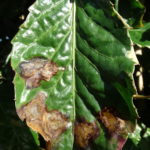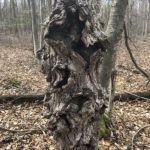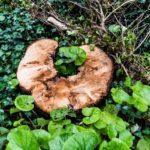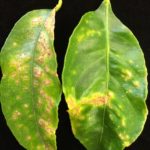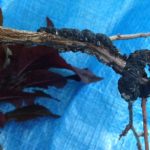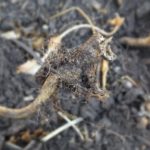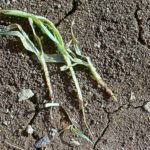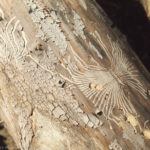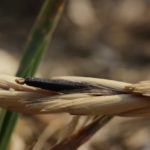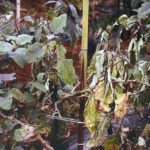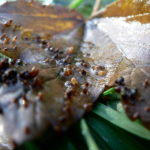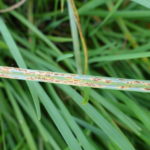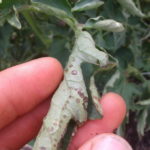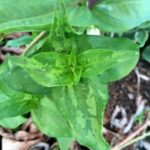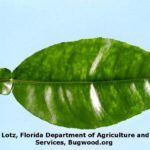The Most Common Plant Diseases
Why are my leaves turning yellow? Why are my plants wilting? Why are my flowers turning brown? Why are my plants dying? If you’re asking yourself these questions, you probably have one of several plant diseases. Common plant diseases are generally broken down into one of three categories: bacterial, viral, or fungal.
Below you’ll find a list of the most common plant diseases, along with a picture, description, symptoms and ways to prevent the diseases in the first place.
Diseases | Description | Symptoms | Prevention | ||
| Aster Yellows | Aster Yellows is a bacterial plant diseases caused by Phytoplasma bacterium. This disease affects over 300 species of broad-leaf herbaceous plants. Aster Yellows tends to thrive in climates that do not exceed 33C/92F degrees, hence why it is never found in tropical climates. This disease is spread by insects, especially Leafhoppers of the Cicadellidae family. | Entire leaves or veins become chlorotic, deformed, greening of flower edges (virescence), reduced root length, sterility, stunting of growth, or growth of additional tiny leaves known as phyllody. | Promptly removing diseased plants and nearby susceptible plants to prevent spreading is the most natural way. If your garden is overrun by Leafhoppers its recommended you purchase certain types of insecticide for pest control. | ||
| Wilt | Wilt can come in a variety of forms, but mainly bacterial or viral. For bacterial wilt caused by Erwinia tracheiphila bacterium, the disease attacks the vascular system of the leaves causing them to deteriorate. Eventually this damage prevents the irrigation of water within the plant and finally plant death. Wilt is most common in cucumbers, gourds, and various types of squash. Bacterial Wilt is transmitted through a variety of plant eating beetles. | Withering and shriveling of leaves. When cut, a discolored bacterial ooze will leak out when squeezed. | Once the diseases sets in, there is no way to remove Bacterial Wilt. The greatest form of prevention involves keeping the amount of beetles present in your garden to a minimum. | ||
| Blight | Blight infestations can come in the form of either bacterial or fungal. Blight is unique in that it can attack a very large variety of plants: Trees, fruit, flowers, vegetables, etc… Blight causes chlorosis and rapid discoloration into browns or dark yellows then eventual death of the plant. | Withering, wilting, browning, or dark yellowing of plant tissue, twigs, leaves, branches, flesh, or body of plants. Eventual blackening and shriveling of the plant. | Blight is best contained through weeding or pruning away the infected area to prevent spreading. If this is not possible, utilizing fungicide or plant antibiotics to kill the bacterial blight are recommended. | ||
| Canker | Canker is a type of plant disease that primarily affects wooded plants such as trees. Canker is brought on by soil nutritional imbalance, root rot, nematodes, drought, insect infestation, or severe cold. Canker not only destroys the affect area, but will also damage all nearby foliage. | Irregular damage to wood such as: flattening, discoloration, distorted, swollen, or cracked areas. | Canker prevention takes you back to basics with gardening. Maintaining fertile soil, avoiding overcrowding, overwatering, pest control, and protecting the trees utilizing tree wraps while young will help prevent canker. | ||
| Crown Gall | Crown Gall is caused by the bacterium Agrobacterium tumefaciens. It is mainly found on herbaceous plants such as berries or roses, but it is also commonly found on shrubs or nut trees. Crown Gall can stunt the growth of your plants by preventing water from moving past the gall making the affected area weak and susceptible to abrasions, insects, and other external factors. Young plants with galls or swelling should be avoided as the gall will prevent growth and lead to plant death. | Bulbous clusters or wart-like growths generally 2-3 inches in size. These growths appear as tumors near the soil line, lower stems, or roots. The color is usually brown, black, light yellow or greenish. | To prevent Crown Gall, thoroughly inspect any new plants, especially around the roots for signs of gall. If any gall is found, cutting or removing the gall early will enable the plant to grow. | ||
| Rot | Rot is one of the most common plant diseases and is created through an amalgam of soil-borne fungi and bacteria. Rot is identified by greyish decomposition and putrefaction of the plant. | Rot creates a layer of decay typically in the form of hard or dry crust on the plant. If you live in a moist climate, rot can sometimes take on a soft spongy texture, especially if you live in a swampy area. On fruits and vegetables rot usually is identified by the addition of mold growth. | Unfortunately, once rot has set in the only way to remove rot is by cutting it away, so preventing rot from the start is critical. Making sure your plants or trees are growing in nutritional soil that is properly watered, and kept clear of insects, rodents, nematodes, and fungi is the best way to maintain a healthy plant and avoid rot. | ||
| Scabs | Scabs look exactly as you would expect them to, like human scabs. They are hard crusty growths that can affect fruits, tuberous plants, and leaves. Scabs are notorious for growing on potatoes and are characterized by their greyish crust on the skin. While common on potatoes, the potato is still perfectly safe to consume if the skin is removed and the potato is cooked thoroughly. Scabs have increased rates of infection on plants in dry alkaline soil. | Hard greyish crusty wart-like bumps. Fruit or leaves with scabs tend to wither early and drop to the ground quickly. | Scab prevention starts before planting. By rotating your crops and soil each year, you can greatly reduce scabs from forming on your plants. We also recommend maintaining a proper pH balance for your soil. Utilizing a soil pH kit will help determine if your soil is too alkaline. To lower the pH levels of alkaline soil, try adding elemental sulfur to balancing out the soil. | ||
| Anthracnose | Anthracnose is most commonly caused by the Gloeosporium or Colletotrichum fungi. This fungi tends to attack many varieties of grasses, annuals, and trees, especially ash, oak, maple, and sycamore trees. | Characterized by the withering and wilting of plant tissue, usually on the shoots or leaves. Anthracnose can cause lesions or spots on plants similar to blight damage. | Starting with disease-free seed or resistant varieties is always a good start. If Anthracnose has already set in, cutting away the diseased area and spraying your plants or trees with fungicides should do the trick. | ||
| Black Knot | This disease is devastating if kept unchecked in a commercial orchard. This fungus, Apiosporina morbosa, is notorious for infecting fruit-bearing plants, especially plum, cherry, or apricot plants. | As the name suggests, this fungus grows until it becomes a large black knot, or ball on the twigs and branches of trees. These large black knots will continue to grow in size, cutting off valuable nutrients to the affected area. If the black knot grows early in the trees life cycle, it can kill the entire tree. | Pruning or cutting off any affected areas will help prevent the spread of Black Knot. If you notice any infected fruit on the ground, clear away the infected fruit to prevent the fungi from infecting the local soil. | ||
| Clubroot | This disease is harder to sometimes diagnose, as the name suggests, it affects the roots of a plant. The roots grow large masses of stunted roots that distort into “clubs” which prevent the plants from meeting its nutrient requirements for healthy growth. This disease is most common in broccoli, cabbage, cauliflower, radishes, brussels sprouts, turnips, and other plants belonging to the Brassicaceae family. It is estimated that anywhere between 8-12% of all Brassicaceae crops worldwide are affected. | Signs that your plants have Clubroot are minimal above the surface. Many times this diseases can be confused with Aster Yellows or Wilt as the plant will show signs of yellowing and weakening. The most tell-tale sign is stunted growth of the plant when compared to neighboring plants. Only digging out the plant and checking the roots will provide confirmation. | Maintenance of your soil is the best defense against Clubroot as it can remain in your soil for over 10 years in some cases, so preventative care is priority. Clubroot is more common in cool, damp, and acidic coils. Maintaining proper pH balance and making sure your soil is properly drained and rotated will help prevent this diseases from setting in. | ||
| Damping-Off | Damping-Off (or damping off) is a type of horticultural disease that destroys the roots of a plant, typically before planting. This means it mainly affects seeds or seedlings. This disease is caused by a number of fungus including but not limited to: Alternaria, Botrytis cinerea, Fusarium, Macrophomina phaseoli, Phyllosticta, Phytophthora, Pseudomonas, Pythium, Rhizoctonia solani, Sclerotium rolfsii, and Thielaviopsis. | Seedlings show signs of Damping-Off as thin and tough stems that look similar to “wire.” This toughening of the stems is a sign of root decay. If your seedlings are already planted, the Damping-Off will cause your newly sprouted plants to wilt and collapse early on. | Early outbreaks of this fungus can be controlled by fungicide. In most cases, Damping-Off can be prevented by careful inspection of seeds or seedlings prior to planting and discarding any infected seeds early. Maintaining a properly watered and well lit soil can help maintain the earth and prevent spreading of infected plants to nearby plants. | ||
| Dutch Elm Disease | As the name suggests, Dutch Elm Disease affects Elm trees and is caused by the ascomycete fungi Ophiostoma. The disease is commonly spread by the elm bark beetle. When the female elm bark beetle lays its eggs in an already infected elm tree, the newly hatched beetles end up covered in fungal spores. These new beetles covered in fungus now fly to new trees, and thus the cycle continues. | Infected trees will have weak branches that wilt and turn greenish yellow and will effectually fall. Young elm trees will wither and die-off within a few months, while older more mature trees can take years. Due to similar symptoms, the only confirmation for this fungus is a lab culture. Removing the bark from your Elm tree revealing bark beetle tunneling can also aid in confirmation. | A long lasting insecticide sprayed onto your trees to prevent bark beetles from nesting is an excellent defense. Some claim that directly injecting a fungicide into the sapwood layer of an elm tree should help kill off any new fungus. Although, this method is more preventative care, than reactionary. Any existing infected trees should be debarked or destroyed before Spring. | ||
| Ergot | A fungal disease caused by the ascomycete Claviceps purpurea. Ergot attacks cereal grasses, especially rye. A cereal grass is any type of grass or grain grown for consumption. Infected grasses will develop black bulbs or kernels, that are poisonous. Accidental ingestion of Ergot kernels can result in hallucinations, convulsions, gangrene, or even death in extreme cases. | Large black lumps or kernels forming on the ears of cereal grasses. Infected grasses are not infected throughout, and can usually be cleaned off by brushing or cutting off infected parts of the grain. Typically Ergot’s fall off the grain during harvest due to the violent nature of a mechanical harvest. | Ergot prevention begins before planting. Verifying the quality of seeds being planted can go a long way. Crop rotations with a deep plow to bury any existing fungus is also critical. | ||
| Fusarium Wilt | Caused by the soil inhabiting fungus Fusarium oxysporum, this disease is not bacterial in the way traditional Wilt is. This fungus affects hundreds of fruits and vegetables and can last indefinitely in the soil. Infected bananas have a special name for this disease, the Panama disease. | Similar to bacterial Wilt, the infected plants will have stunted growth, turn a greenish yellow color, wither, and die. Any infected seedlings will wither and die very early. | Due to the longevity of Fusarium Wilt, crop rotation is an ineffective method. Utilizing soil fungicides can help control some strains of this fungus. If caught early, cutting away any infected areas will help save the remaining parts of the plant. | ||
| Leaf Blister | A non-lethal plant fungus caused by the fungi Taphrina. Leaf Blister, aka Leaf Curl, is characterized by its curling of infected leaves, and blistering. Infected plant leaves will grow boils of varying colors: red, purple, yellow, brown, white, or black. | Leaves with curling or colored blisters: red, purple, yellow, brown, white, or black. Affected leaves or fruit will fall to the ground early. Fruits also tend to swell and become distorted. This fungus is common in drupes, aka stone fruits: Peaches, cherries, apricots, plums, etc… | Application of gentle fungicides each year will help control this disease. | ||
| Mildew | Tiny white fruiting structures created by fungus. Mildew is not only common on fruits and vegetables, but can be found in damp clothes, leather products, and other fibrous household goods. This type of fungus has a very distinct oder. Inhalation of mildew particles can cause respiratory irritation. Depending on the plant, mildew can come in the form of downy mildew, or powdery mildew. Mildew is not very harmful to most plants, but can weaken the plant and make it more susceptible to other diseases. | White powdery substance growing on the tops of fruits, vegetables, or plant leaves. | Removal of mildew can be done with either cutting away affect areas, using gentle fungicides, or by hand with alcohol wipes. | ||
| Rust | Rust gets in name from how it visually compares to that of iron rust. Rust is caused by the fungi of the phylum Basidiomycota. The rust can appear on leaves, shoots, or fruits and is characterized by its yellow, red, orange, brown, or even black color. | Identified by its powdery rusty appearance of yellow, red, orange, brown, or black “rust.” Rust affected plants will eventually wither and die. | Basic fungicides should help contain this fungus and prevent spreading. | ||
| Smut | Smut is a plant disease caused by a variety of fungal spores. The smut looks similar to chimney soot, a fine black powder. Another name for Smut is Bunt which is found in rye, wheat, other cereal grasses, and corns. If the small black dust is popped open, it releases a foul odor. | Small black powder resembling chimney soot. | Containing Smut is handled by destroying infested crops before the wind can spread the smut to other plants. The air will carry the black smut to nearby plants causing further infestation. Also treating smut infected plants with fungicide can help. | ||
| Curly Top | Viral disease caused by the curtovirus that affects a large variety of ornamentals and vegetables, including but not limited to: beets, carrots, eggplants, spinach, squash, and tomatoes. Insects, especially leafhoppers are notorious for spreading this disease from plant to plant. | Stunted growth, yellow and thickened leaves that wither and die early. | Utilizing insecticide to kill off any insects carrying the virus is critical. Purchasing curtovirus resistant plants is also recommended. | ||
| Mosaic Virus | Mosaic plant virus is caused by numerous strains of viruses and affects hundreds of different plants. Mosaic is notorious for hurting economic crops that are mass harvested, in particular: Bean Common Mosaic Virus, Bean Yellow Mosaic Virus, Cucumber Mosaic Virus, and Tobacco Mosaic Virus. Mosaic typically doesn’t kill the plants, but stunts and weakens the plant making them more susceptible to other diseases or insects. | Stunted plant growth combined with crinkled or blistered leaves with many light or dark green, yellow, or white spots. | Like with most diseases, planting resistant varietals should be your first line of defense. If plants are lightly infected, utilizing antiviral or a weak bleach and water solution can help kill off the virus. If your plants are heavily infected, removing and destroying the plants is recommended as the virus can remain in compost piles then be spread to other plants. | ||
| Psorosis | Psorosis is a viral diseases that primarily affects citrus crops such as oranges, grapefruits, lemons, limes, tangerines and other citrus fruits. Unlike other diseases, Psorosis is usually contracted via plant grafting. The disease is slow to infect the trees and usually takes anywhere between 5-10 years before continues signs are visible. | Infected trees produce inedible fruit. Much of the fruit is severely stunted and is usually 30% of its normal size. Much of the bark will have blisters, the leaves will have yellow spots and show signs of withering or mottling. | Early prevention is key for Psorosis. Once it has taken effect, its not possible to remove from fully grown trees. Ensuring your trees are disease free from the onset is critical. Scraping away infected bark might help delay further spreading, but the tree will eventually die. It is best to remove the entire tree, and plant a new one. |






